Breathtaking and unquestionably stunning, roan horses are very coveted in the equine world. Their unique coloring looks as if they have been permanently dusted with snow or powdered sugar!
It is a coloration that is almost instantly recognizable, making roan horses highly sought after and desired by equestrians around the world.
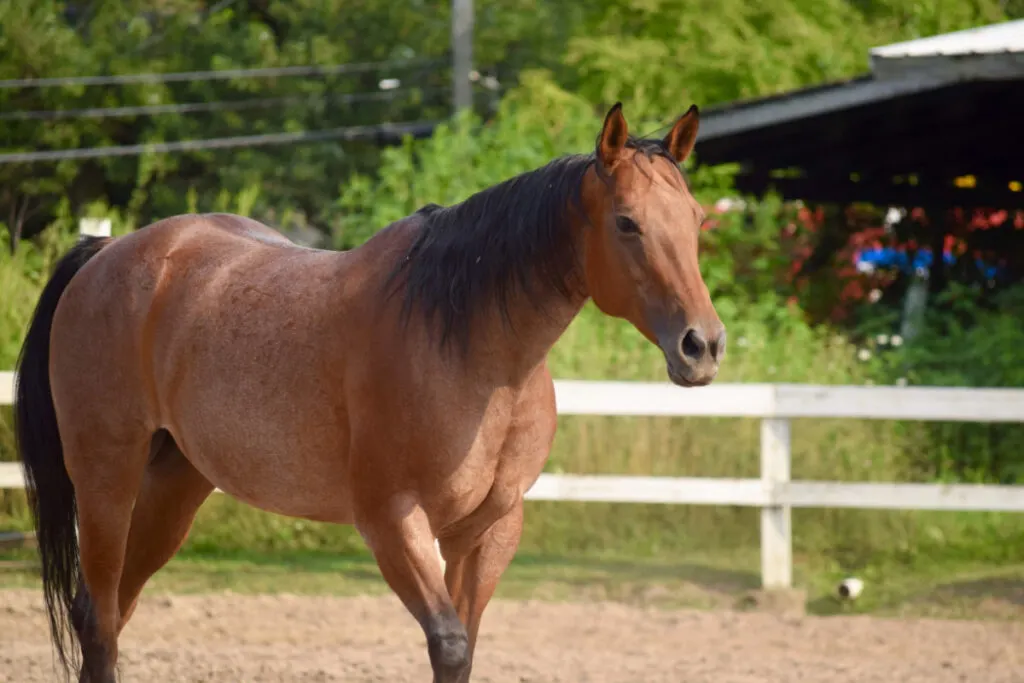
Roans are not a breed all their own, as some may mistakenly believe. Roan patterns in horses are the result of a unique genetic composition that exists in various breeds and presents itself on different base horse colors.
Table of Contents
What is a Roan Horse?
Roan horses have a unique roan coat pattern, an even and visually appealing blend of white and colored hair within an animal’s coat. This distinctive color pattern causes the majority of a horse’s coat to appear much lighter than its base color.
A roan horse’s head and the lower portion of their legs are usually in an almost or completely solid color. (source)
What is a Classic Roan Pattern?
The classic roan pattern is the pattern most often referred to when someone calls a horse a roan.
Genetically, classic roan horses, also called true roans, are different from horses that have other roan-mimicking patterns.
The classic roan pattern, apart from its genetic difference, is visually different from other roan patterns as well.
The white, unpigmented hairs are mixed evenly throughout the roan-patterned area. In other roan-like patterns, the hairs are not mixed evenly.
Roan Coat Color Genetics
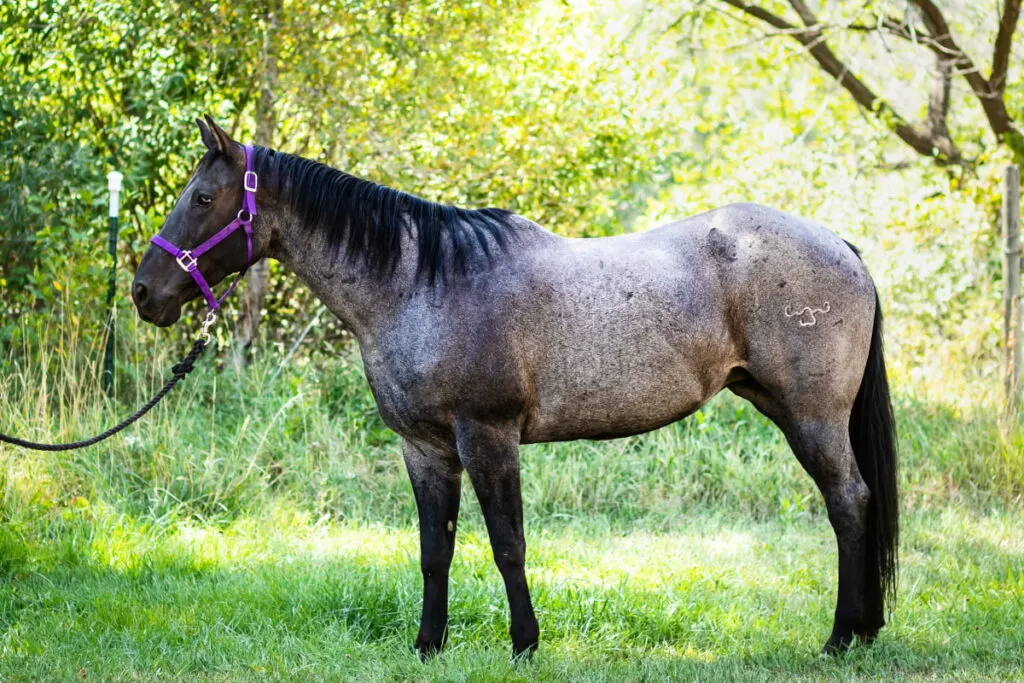
The classic roan coat coloration is an inherited trait through an autosomal dominant gene. Sounds complicated, but it is not as complex as it seems.
In laymen’s terms, it simply means that the roan trait is passed down from the parents and that only one copy of the gene is needed to display the trait. (source)
If a horse inherits the roan gene from at least one of its parents, it will have display roan pattern on its coat. If the horse does not inherit at least one copy of the roan gene, even if one of its parents is roan or a descendant of true roan-patterned horses, it will not have the roan color pattern. (source)
Testing for Roan Zygosity
The actual genetic mutation has not been scientifically discovered which means there is no test can that test specifically for that gene.
DNA marker testing can be done to see whether or not a horse possesses the roan zygosity, a sequence of genes that are known to result in roan coloring. This test is called the Roan Zygosity Test and it costs around $40 per test.
Be sure to check out our article on DNA tests available for horses for labs that can perform the roan test.
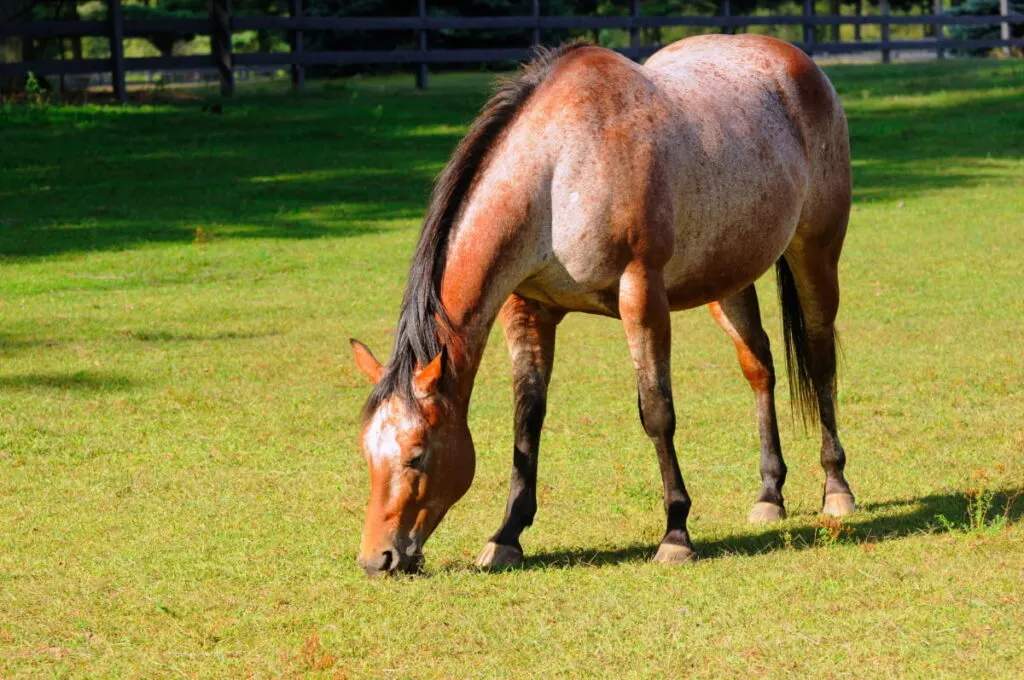
A horse that has a double classic roan gene, meaning both parents passed it along to their offspring, then that horse is likely to have offspring that are roan. A horse that did not inherit the roan genetic marker from either of its parents has no chance of producing roan-colored offspring.
Horses that inherit the roan gene from one or both of their parents will have the roan pattern in their coat.
Roan Zygosity Test Results
According to the UC Davis Veterinary Genetics Lab, these are the only three genetic possibilities when it comes to the roan horse color:
| Result | Explanation | Roan Coloration | Chance of Roan Offspring |
| N/N | Horse does not have any roan genetic markers. | No display of classic roan color pattern. | Zero |
| N/Rn | Horse inherited 1 copy of the roan genetic marker. | Definite display of classic roan color pattern. | About 50% |
| Rn/Rn | Horse inherited 2 copies of the roan genetic marker, 1 from each parent. | Definite display of classic roan color pattern. | Very high chance. |
Common Variations of Classic Roan Colors
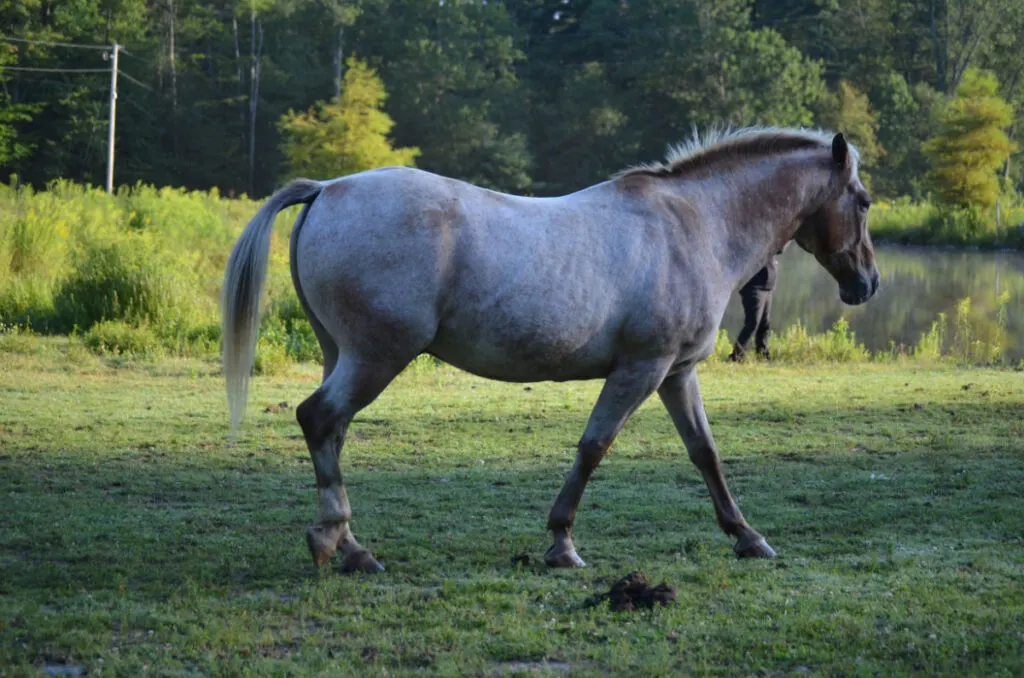
All roan horses have the natural horse base colors and the roan pattern is simply interspersed within it.
There are 3 specific classic roan variations that are most often recognized by horse registries. These are the most common variations of the true roan pattern trait.
Red/Strawberry Roan
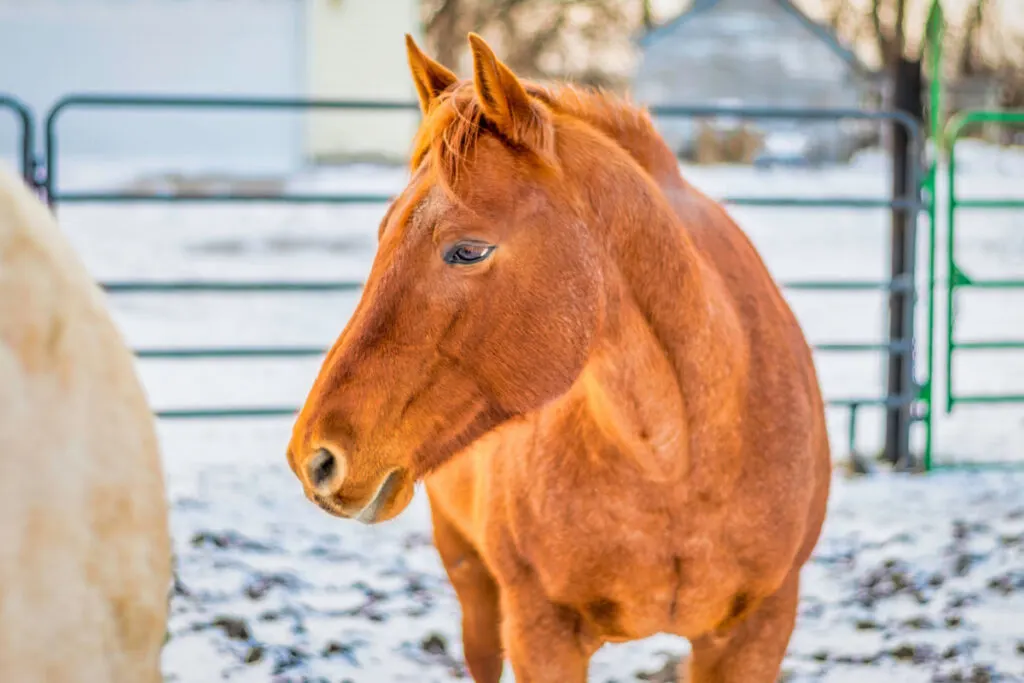
Red roan is the term used to describe roan horses that have a deep chestnut-based coat. Strawberry roan is the terminology used to describe lighter chestnut-colored horses because they appear more strawberry red with the roan pattern.
Solid chestnut colored horses can have a light to dark reddish-brown coat pattern throughout their entire body, including their lower legs.
It is important to know that the term red roan was once used to refer to bay-colored roan horses, but bay roans were eventually given their own category.
Bay Roan
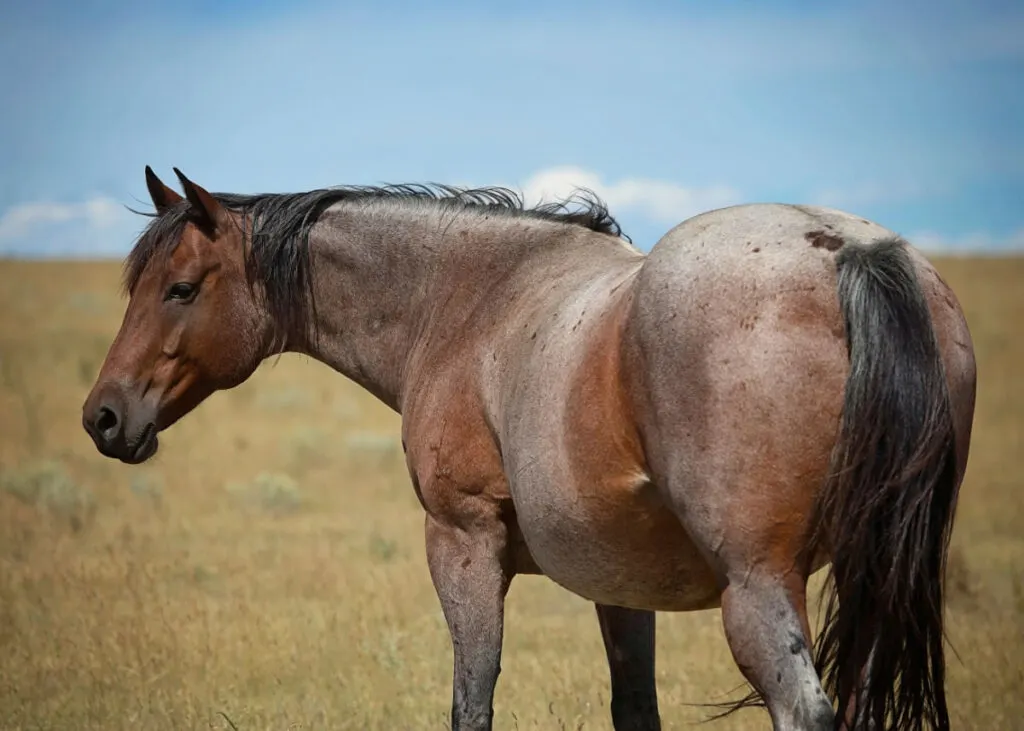
A bay roan is a horse that exhibits the roan pattern but has a bay-colored base coat. A solid bay horse has a light to deep reddish-brown coat like that of a chestnut horse.
A bay is set apart from chestnut horses by its noticeably solid black lower legs as well as its black mane and tail. Bay horses, as well as bay roans, also have black skin under most of their hair, unless it is under a white marking on their face.
Blue Roan
Blue roan horses appear to have a bluish-tinted coat, but they have a black-colored base coat. The roan coloring makes the horses appear bluer than just gray or black, hence the given name of blue roan.
It is important to know that blue roans can sometimes appear solid when first born, but they their coats can evolve into the roan pattern if they carry the roan pattern gene.
Uncommon Variations of Roan Colors
Palomino Roan
Although it is rare, it is possible to come across a palomino roan. A palomino-colored horse has a gorgeous golden coat with a white or yellowish-white mane and tail.
Genetically, the color is the result of an inherited cream dilution gene that creates the light golden color. (source) When combined with a roan gene mutation, the result is a gorgeous palomino roan.
Buckskin Roan
Buckskin horses have tan colored bodies with black lower legs, manes and tails. The coloration is the result of a cream dilution gene in a bay colored horse.
Buckskin roans will have black legs, black mane and tails as well as tan or golden hair with white evenly interspersed throughout the rest of their bodies. (source)
Dun Roan
Dun roans are roan colored horses that have a dun base color. Duns can be red, tan, or black. Horses that have dun coloring have a lighter, diluted body color with darker shading on their legs, manes and tails.
They have a definitive darker shaded stripe that runs down their backs, a trait that sets them apart from bays and other horse colors that may appear dun-like. (source)
Roan x Paint
Paints horses can also have roan color variations! Paints can have roan coloring including all the different roan shades including bay, sorrel, chestnut, black, dun, black, and palomino.
Paint horses with roan coloring can have large areas of white with colored areas that contain the roan pattern. Do not forget, paints can be solid with no white, but have paint horse genetics. (source)
Other Roan-like Patterns
Unfortunately, there are some roan-like patterns that are often confused with true roans. It is even more confusing because these patterns are called roaning, even though they are not classic roan patterns.
Here are some of the more common roan-mimicking patterns you may see.
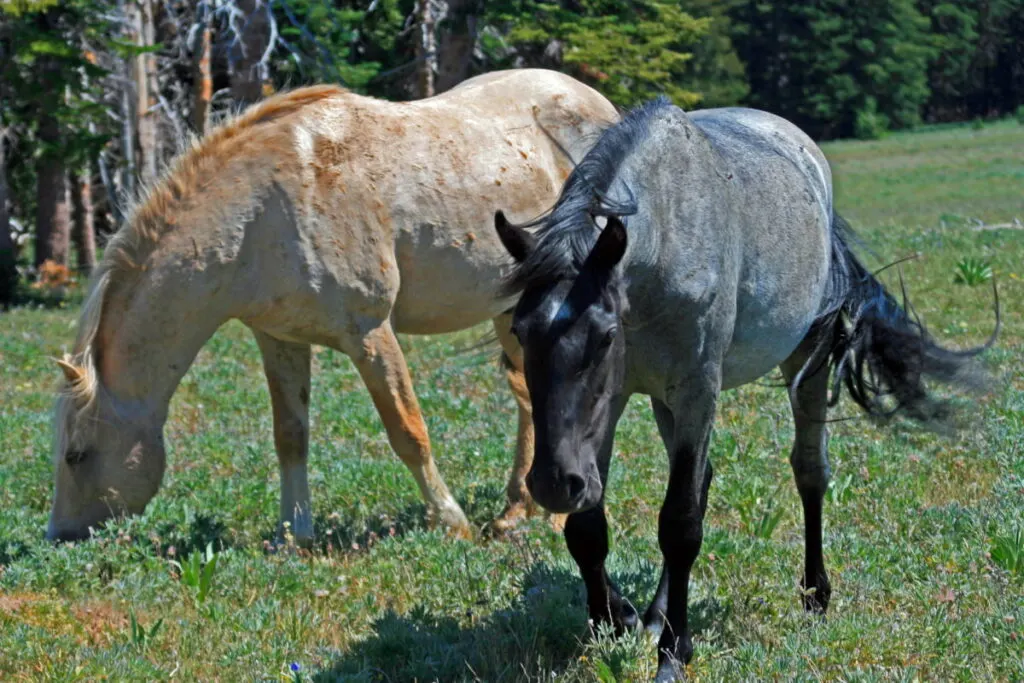
Grulla ‘Roan’
Grulla, also called grullo, is a horse color grouped within the dun horse color family. Like duns, grulla horses have lighter bodies with darker legs, manes and tails.
Black-based duns also called blue duns, are also referred to as grulla roans. They do not have evenly interspersed white hairs like classic roans do, instead they have interspersed shades of mouse-gray colored hairs mixed with their base color.
A grulla roan’s shading can appear silver, blue, black, or gray. They technically are not roans, as they do not have the classic roan genetic markers.
Their appearance is roan-like and many equestrians mistakenly assume that grulla horses are true roans. (source)
Rabicano
The rabicano pattern, also referred to as white ticking, is a roaning pattern that is easy to recognize. It is distinctly different from the classic roan pattern because the white interspersed hairs are not evenly spread out. This causes some areas on the horse’s body to be much whiter than others.
The pattern is also lighter in the flank and belly area extending out to different parts of the horse’s body.
There is also a noticeable amount of white ticking on the base of the horse’s tail, a trait that is sometimes the only indicator that a horse has the rabicano pattern. (source)
Sabino
Sabino patterned horses are characterized by their white spotted areas. The white markings have roaning in their edges, where the white hairs intermix with the colored hairs.
Some horse enthusiasts mistake sabino horses for having a true roan gene, but they do not. If the sabino pattern is minimally expressed, it may simply look like a normal paint horse.
If it is exponentially expressed, a sabino horse can look a lot like a classic roan. (source)
Varnish
Varnish roans look a lot like a classic roan, but unlike true roans, their color will change over time. Varnish roans can have areas of solid color, as well as white roaning on the horse’s legs and head, unlike classic roans. As varnish roan horses age, the amount of white hairs throughout their coats will increase.
Varnish roans are also not genetically related to classic roan horses. Instead, they are a variation of leopard complex patterns in breeds like the Noriker, Appaloosa, and the Knabstrupper horse. (source)
Coat Color Changes
Seasonal
Horses with classic roan patterns will often undergo slight changes throughout the year as the seasons change.
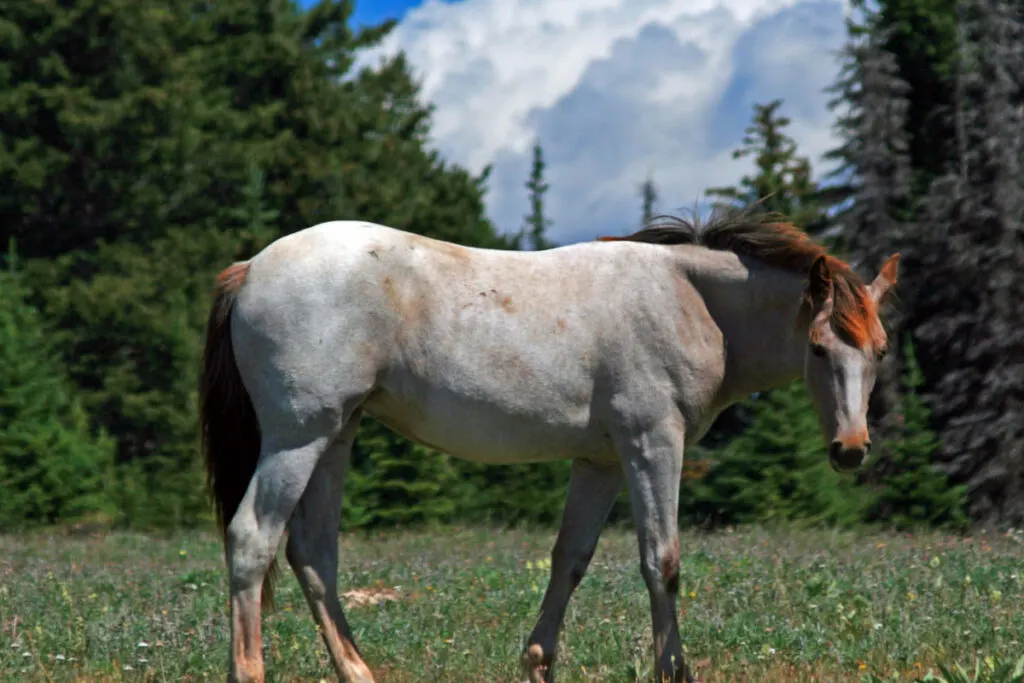
Weather changes will cause a horse to grow thicker coats of hair during cold months, which can cause a noticeable lightening or darkening in the color of any horse, especially roans.
They will return to their normal roan shade during the spring and summer.
Injured Areas
Classic roan coloring will not fade over time. There are times when certain areas on a roan’s coat will change for various reasons.
Sometimes, when a roan horse is scratched or suffers a wound that causes hair loss, the hair will grow back in a solid color instead of with the normal roan pattern.
These spots or areas are referred to as corn marks. These spots have also been known to appear in areas that did not visibly suffer an injury.
The “Lethal Roan” Myth
Unique colorings in some animals, such as the merle coloring in dogs, can result in a “lethal” or dangerous combination when two animals that carry the gene are bred together.
Researchers in the late 1970s mistakenly believed that breeding a classic roan horse to another classic roan could create a lethal combination.
They fear that it was causing embryos to stop developing early the process. Today, however, the Veterinary Genetics Laboratory at UCDavis disputes that idea and says that it is not true. (source)
19 Horse Breeds with Roan Prevalence
Not every horse breed is capable of or known to produce roan color variations. The classic roan pattern has never been scientifically confirmed in Arabians or Thoroughbreds, despite some appearing as roans. The following breeds have common incidences of the classic roan pattern.
- Quarter Horse
- Paint Horse
- Mustang Horse
- Tennessee Walking Horse
- Appaloosa Horse
- Half-Arabian
- Shetland Pony
- Gypsy Cobs
- Spanish Mustang
- Icelandic Horse
- Welsh Pony
- Miniature Horse
- Paso Fino
- Peruvian Paso
- Belgian
- Brabant
- Ardennes
- Standardbred
- Trait Du Nord
Final Thoughts
There is no argument that roan horses are visually appealing, so much so that they are often considered extraordinary among horse lovers. Not every horse with a roaning pattern is a classic roan, but there are easy ways to tell them apart.
Asides from a test, a close visual inspection of a horse’s coat will often do the trick. True roan horses will have evenly distributed white hairs within their colored coat, except for on their heads and legs.

